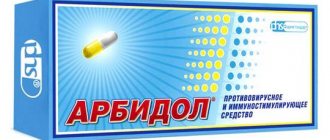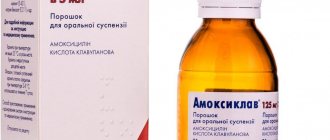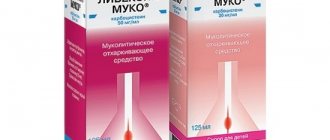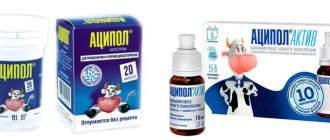Description of pharmacological action
A combined drug containing two active ingredients: the sulfonamide drug sulfamethoxazole and the diaminopyrimidine derivative trimethoprim. Also available under the names: Biseptol, Septrin, Abacin, Abactrim, Andoprim, Bacterial, Bacticel, Bactifer, Bactramin, Bactrimel, Bactrin, Bactrisol, Berlocid, Biseptol, Chemitrin, Doctonil, Ectapprim, Espectrin, Falprin, Gantrin, Infectrim, Metomide, Microcetim, Nolapse, Oradin, Oribact, Potesept, Primazol, Resprim, Septocid, Septrin, Sumetrolim, Trimexazol, Trixazol, Uroxen, Vanadyl, etc. Sulfamethoxazolum . 3-(para-Aminobenzenesulfamido)-5-methylisoxazole. Synonyms: Gantanol, Metoxal, Radonil, Sunomin, Sulfamethoxazole, Sulfamethylisoxazole, Sulfisomezole, Sulphamethoxazole. It is an antibacterial drug similar in chemotherapeutic activity to other sulfonamide drugs. Trimethoprim. 2,4-Diamino-5-(3, 4, 5-trimethoxybenzyl)-pyrimidine. Inhibits the vital activity of E. coli, which leads to a decrease in the synthesis of thymine, riboflavin, nicotinic acid and other B vitamins in the intestine. The duration of the therapeutic effect is 7 years.
Indications for use
Bactrim should be prescribed only in cases where, in the opinion of the physician, the benefits of such therapy outweigh the possible risks; it is necessary to resolve the question of whether it is possible to dispense with the use of one effective antibacterial agent. Since the sensitivity of bacteria to antibiotics in vitro varies across different geographic areas and over time, local differences in bacterial susceptibility should be taken into account when choosing a drug. Respiratory tract infections: exacerbation of chronic bronchitis, otitis media in children, if there are sufficient reasons to prefer a combination of TMP and SMZ to antibiotic monotherapy. Treatment and prevention (primary and secondary) of pneumonia caused by Pneumocystis carinii in adults and children. Infections of the genitourinary tract: urinary tract infections, gonococcal urethritis, chancroid. Infections of the gastrointestinal tract: typhoid and paratyphoid fever, shigellosis (caused by sensitive strains of Shigella flexneri and Shigella sonnei if antibiotic therapy is indicated), travelers' diarrhea caused by enterotoxic strains of Escherichia coli, cholera (in addition to fluid and electrolyte replacement). Other bacterial infections: infections caused by a range of microorganisms (possibly in combination with other antibiotics), e.g. brucellosis, acute and chronic osteomyelitis, nocardiosis, actinomycetoma, toxoplasmosis and South American blastomycosis.
BACTRIM: reviews
The first time I encountered this drug was when my child fell ill; he was then 1 year and 4 months old. It all started with a hoarse throat and dry cough. No runny nose, no fever, just a drop in the voice and a cough, all of a sudden. We went to the doctor, he did not find any wheezing in the lungs, but he prescribed us a bunch of medications, among which was Bactrim.
After reading the instructions, I was a little taken aback by how many side effects and contraindications this drug has. But still, she listened to the doctor’s recommendation and gave the medicine to the child as prescribed. By the way, the kit includes a measuring spoon, but I didn’t find it very convenient. In my opinion, it is too wide to fit into a child’s mouth. And my boy really didn’t like the sweet smell of the suspension. That's why we used …read more
measuring syringe.
According to the instructions, “Bactrim” is an antimicrobial drug based on a combination of trimethoprim and sulfamethoxazole. Despite the fact that its effect is similar to antibiotics, this drug is not an antibiotic. In general, the drug is prescribed to children from 3 months, but in some cases it is used from 6 weeks. The medicine can be used only as prescribed by a doctor, and only if the benefits of its use outweigh the risk to the patient’s health.
And, of course, I would like to note that the medicine “Bactrim” has a huge list of side effects and contraindications, so you need to be very careful.
Fortunately for me and my child, we had no adverse reactions. And, I must say, the drug helped us a lot, we cured our cough and sore throat. We had a course of treatment of 5 days, during which time my baby completely recovered.
The advantage of this product, which is produced in France, is its low cost. Our medicine costs only 153 rubles, you agree, this is not much. But I want to note once again that the instructions for the drug “Bactrim” are simply huge, there are many contraindications.
Therefore, I urge everyone: be careful when using medications, use them only as prescribed by a doctor and, under no circumstances, do not self-medicate! Be healthy!
The first time I encountered this drug was when my child fell ill; he was then 1 year and 4 months old. It all started with a hoarse throat and dry cough. No runny nose, no fever, just a drop in the voice and a cough, all of a sudden. We went to the doctor, he did not find any wheezing in the lungs, but he prescribed us a bunch of medications, among which was Bactrim.
After reading the instructions, I was a little taken aback by how many side effects and contraindications this drug has. But still, she listened to the doctor’s recommendation and gave the medicine to the child as prescribed. By the way, the kit includes a measuring spoon, but I didn’t find it very convenient. In my opinion, it is too wide to fit into a child’s mouth. And my boy really didn’t like the sweet smell of the suspension. That's why we used a measuring syringe.
According to the instructions, “Bactrim” is an antimicrobial drug based on a combination of trimethoprim and sulfamethoxazole. Despite the fact that its effect is similar to antibiotics, this drug is not an antibiotic. In general, the drug is prescribed to children from 3 months, but in some cases it is used from 6 weeks. The medicine can be used only as prescribed by a doctor, and only if the benefits of its use outweigh the risk to the patient’s health.
And, of course, I would like to note that the medicine “Bactrim” has a huge list of side effects and contraindications, so you need to be very careful.
Fortunately for me and my child, we had no adverse reactions. And, I must say, the drug helped us a lot, we cured our cough and sore throat. We had a course of treatment of 5 days, during which time my baby completely recovered.
The advantage of this product, which is produced in France, is its low cost. Our medicine costs only 153 rubles, you agree, this is not much. But I want to note once again that the instructions for the drug “Bactrim” are simply huge, there are many contraindications.
Therefore, I urge everyone: be careful when using medications, use them only as prescribed by a doctor and, under no circumstances, do not self-medicate! Be healthy!
Rating: 4 4
Source:
otzovik.com
Pharmacodynamics
A combined antimicrobial drug consisting of sulfamethoxazole and trimethoprim. Sulfamethoxazole, similar in structure to PABA, disrupts the synthesis of dihydrofolic acid in bacterial cells, preventing the inclusion of PABA in its molecule. Trimethoprim enhances the effect of sulfamethoxazole by interfering with the reduction of dihydrofolic acid into tetrahydrofolic acid, the active form of folic acid responsible for protein metabolism and microbial cell division. It is a broad-spectrum bactericidal drug, active against the following microorganisms: Streptococcus spp. (hemolytic strains are more sensitive to penicillin), Staphylococcus spp., Streptococcus pneumoniae, Neisseria meningitidis, Neisseria gonorrhoeae, Escherichia coli (including enterotoxogenic strains), Salmonella spp. (including Salmonella typhi and Salmonella paratyphi), Vibrio cholerae, Bacillus anthracis, Haemophilus influenzae (including ampicillin-resistant strains), Listeria spp., Nocardia asteroides, Bordetella pertussis, Enterococcus faecalis, Klebsiella spp., Proteus spp., Pasteurella spp., Francisella tularensis , Brucella spp., Mycobacterium spp. (including Mycobacterium leprae), Citrobacter, Enterobacter spp., Legionella pneumophila, Providencia, some species of Pseudomonas (except Pseudomonas aeruginosa), Serratia marcescens, Shigella spp., Yersinia spp., Morganella spp., Pneumocystis carinii; Chlamydia spp. (including Chlamydia trachomatis, Chlamydia psittaci); protozoa: Plasmodium spp., Toxoplasma gondii, pathogenic fungi, Actinomyces israelii, Coccidioides immitis, Histoplasma capsulatum, Leishmania spp. Resistant to the drug: Corynebacterium spp., Pseudomonas aeruginosa, Mycobacterium tuberculosis, Treponema spp., Leptospira spp., viruses. Inhibits the vital activity of E. coli, which leads to a decrease in the synthesis of thymine, riboflavin, nicotinic acid and other B vitamins in the intestines. The duration of the therapeutic effect is 7 hours.
Indications for use of Bactrim
The main indication for the use of an antibiotic is an infectious disease caused by bacteria sensitive to sulfamethoxazole and trimethoprim.
The instructions indicate that the medication is prescribed:
- with tonsillitis;
- for the treatment of chronic bronchitis and pneumonia;
- with bacterial diarrhea;
- with damage to the urinary tract;
- with respiratory tract infection;
- after surgery as a prevention of complications.
Often used for chronic and acute osteomyelitis, prostatitis in men, dysentery in adults and children.
Pharmacokinetics
Absorption: After oral administration, TMP and SMZ are rapidly and almost completely absorbed from the upper gastrointestinal tract. After a single dose of 160 mg TMP + 800 mg SMZ, the maximum concentrations of TMP in plasma are 1.5-3 m g/l, and SMZ - 40-80 m g/l. With repeated doses every 12 hours, the minimum equilibrium concentrations after 2-3 days stabilize within 1.3-2.8 m g/ml for TMP and 32-63 m g/ml for SMZ. Distribution The volume of distribution of TMP is about 130 l, SMZ is about 20 l. 45% of TMP and 66% of SMZ are associated with plasma proteins. TMP penetrates slightly better than SMZ into non-inflamed prostate tissue, seminal fluid, vaginal secretions, saliva, healthy and inflamed lung tissue and bile, while into the cerebrospinal fluid and aqueous Both components of the drug penetrate the moisture of the eye equally. Large amounts of TMP and slightly smaller amounts of SMZ enter the interstitial and other extravasal body fluids from the bloodstream, while the concentrations of TMP and SMZ exceed the minimum inhibitory concentrations for most pathogenic microorganisms. In humans, TMP and SMZ are found in the placenta , umbilical cord blood, amniotic fluid and fetal tissues (liver, lungs), which indicates the penetration of both substances through the placental barrier. Typically, TMP concentrations in the fetus are similar to those in the mother, and concentrations of SMZ in the fetus are lower than in the mother. Both substances are excreted in breast milk. Concentrations in breast milk are similar (TMP) to or lower (SMZ) than those in maternal plasma. Metabolism: Approximately 50-70% of a TMP dose and 10-30% of a SMZ dose are excreted unchanged. The main metabolites of TMP are 1- and 3-oxides and 3′- and 4′-hydroxy derivatives. Some metabolites have antimicrobial activity. SMZ is metabolized in the liver, predominantly by N4-acetylation and, to a lesser extent, by conjugation with glucuronic acid. Elimination The half-lives of the two components are very close to each other (on average, 10 hours for TMP and 11 hours for SMZ). Both substances as well as their metabolites are excreted almost exclusively through the kidneys, both by glomerular filtration and tubular secretion, as a result of which the concentrations of both active substances in the urine are significantly higher than in the blood. A small part of the active substances is excreted in feces. Pharmacokinetics in special clinical cases In elderly patients, as well as with severe renal failure (creatinine clearance 15-30 ml/min), the half-life of both components of the drug increases, which requires dose adjustment.
Use during pregnancy
In animals, very high doses of co-trimoxazole caused fetal malformations typical of folic acid deficiency. Based on studies in pregnant women, literature reviews and anecdotal reports of malformations, Bactrim does not appear to be associated with a significant risk of teratogenicity in humans Since both TMP and SMZ cross the placental barrier and thus can affect folic acid metabolism, Bactrim should be prescribed during pregnancy only if the expected benefit from its use outweighs the possible risk to the fetus. Pregnant women receiving Bactrim are recommended to take 5-10 mg of folic acid per day. In late pregnancy, Bactrim should be avoided due to the possible risk of kernicterus in newborns. Both TMP and SMZ pass into breast milk. Despite the fact that a small amount of Bactrim passes into breast milk, it is recommended to compare the possible risk for the infant (kernicterus, hypersensitivity) with the expected therapeutic effect for the mother.
Contraindications
The drug has a complex effect on the body.
Therefore, from the point of view of specialists, it cannot always be used; all cases of contraindications are recorded in the instructions. Contraindications are renal and liver failure, serious blood diseases (plastic anemia, agranulocytosis, leukopenia, B12-deficiency anemia).
Use this medicine during pregnancy and lactation carefully, always weighing the risks and benefits. Animal studies have shown that Co-trimoxazole leads to fetal pathologies. To avoid miscarriage, treatment with this drug should be accompanied by taking folic acid.
In the last trimester, Bactrim is completely excluded so as not to provoke kernicterus in the newborn. During lactation, small doses of the active substance penetrate into the milk. Therefore, the medicine is recommended to be taken only when the benefit to the mother is more important than the potential kernicterus in the baby or the possible development of hypersensitivity in him. Do not use the medicine if you are hypersensitive to any substance in the composition.
The drug should not be prescribed to children less than 3 months old.
Use for renal impairment
In case of renal failure, the dose depends on the value of CC: with CC over 25 ml/min - standard dose; at 15-25 ml/min – standard dose for 3 days, then half the standard dose. When CC is less than 15 ml/min, half the standard dose is prescribed only against the background of hemodialysis. Dissolve in the following proportions immediately before administration: 480 mg (5 ml of solution for infusion) per 125 ml, 960 mg (10 ml) per 250 ml, 1440 mg (15 ml) per 500 ml of infusion solution. If cloudiness or crystallization of the solution appears before or during infusion, the mixture cannot be used. The duration of administration is 1-1.5 hours (must be consistent with the patient’s fluid needs). If it is necessary to limit the volume of injected liquid, it is administered in higher concentrations - 5 ml is dissolved in 50-75 ml of a 5% dextrose solution in water. For severe infections in all age groups, the dose can be increased by 50%.
The drug "Bactrim" (suspension): instructions for use for children
Reviews of this medication will be described below.
The dosage of the drug for children should be selected only by an experienced specialist. To apply the required amount of suspension, use a measuring spoon (5 ml) included in the kit.
From the age of 12, the dose of Bactrim should be 20 ml twice a day (morning and evening). If long-term therapy is required, doctors recommend taking the drug 10 ml in the morning and the same amount in the evening. For severe diseases, evening and morning doses of 30 ml are allowed.
How long is the drug for children “Bactrim” used for acute infections? Instructions for use (the description of the medicine was presented above) states that for such diseases, the duration of therapy should be at least five days or until all symptoms disappear completely.
Treatment of children without signs of improvement in their condition is a reason to contact a pediatrician to adjust the dose.
For a disease such as chancroid, this medication is prescribed 20 ml twice a day. If after 7 days there are no signs of healing, then therapy can be extended for another week. It should be taken into account that the ineffectiveness of the drug may be associated with the emergence of pathogen resistance.
How to treat uncomplicated acute urinary tract infections? What does the instructions for use say about this? “Bactrim” (syrup), reviews of which are controversial, are prescribed once a day in an amount of 40-60 ml. It is advisable to take the suspension before bedtime.
To prevent pneumonia, children over 12 years of age are given 20 ml of the drug per day.
Side effects
From the nervous system: headache, dizziness; in some cases - aseptic meningitis, depression, apathy, tremor, peripheral neuritis. From the respiratory system: bronchospasm, pulmonary infiltrates. From the digestive system: nausea, vomiting, loss of appetite, diarrhea, gastritis, abdominal pain, glossitis, stomatitis, cholestasis, increased activity of “liver” transaminases, hepatitis, hepatonecrosis, pseudomembranous enterocolitis. From the hematopoietic organs: leukopenia, neutropenia, thrombocytopenia, agranulocytosis, megaloblastic anemia. From the urinary system: polyuria, interstitial nephritis, impaired renal function, crystalluria, hematuria, increased urea concentration, hypercreatininemia, toxic nephropathy with oliguria and anuria. From the musculoskeletal system: arthralgia, myalgia. Allergic reactions: itching, photosensitivity, rash, exudative erythema multiforme (including Stevens-Johnson syndrome), toxic epidermal necrolysis (Lyell's syndrome), exfoliative dermatitis, allergic myocarditis, fever, angioedema, scleral hyperemia. Local reactions: thrombophlebitis (at the site of venipuncture), pain at the injection site. Other: hypoglycemia.
Directions for use and doses
Prescribed orally after meals with a sufficient amount of liquid. Adults and children over 12 years of age are prescribed a daily dose of 4 tablets (or 2 forte tablets, or 8 scoops of syrup). The daily dose is divided into two doses (morning and evening). The course of treatment lasts from 5 to 12-14 days, and for chronic infections it is longer and depends on the course of the disease. For children under 12 years of age, it is preferable to administer the drug in syrup form. Children from 2 to 5 years old are usually prescribed 1 measuring spoon 2 times a day, from 5 to 12 years old - 2 measuring spoons 2 times a day. For children under 2 years of age, the prescription is made by a doctor.
Bactrim instructions
Inside,
after eating with enough liquid.
Bactrim®
Standard dosing for adults and children over 12 years of age is presented in Table 1.
Table 1
| Doses | Suspension for oral administration, measuring spoons | |
| morning | evening | |
| Standard | 4 | 4 |
| Minimum dose and dose for long-term treatment (more than 14 days) | 2 | 2 |
| Increased dose (in especially severe cases) | 6 | 6 |
Duration of treatment
For acute infections, Bactrim® should be prescribed for at least 5 days or until the patient has been symptom-free for 2 days. If after 7 days of therapy there is no clinical improvement, the patient’s condition should be re-evaluated for possible treatment adjustment.
Dosing in special cases
Chancroid.
4 scoops of suspension 2 times a day. If after 7 days healing of the skin element does not occur, therapy can be extended for another 7 days. However, it should be borne in mind that the lack of effect may indicate resistance of the pathogen.
Acute uncomplicated urinary tract infections.
For women with acute uncomplicated urinary tract infections, a single dose of 8-12 scoops of suspension is recommended. If possible, they should be taken in the evening after meals or before going to bed.
Patients on hemodialysis.
After taking the usual loading dose, subsequent doses should be half or a third of the standard dose and given every 24-48 hours.
Pneumonia caused by
Pneumocystis carinii.
Up to 20 mg/kg/day of trimethoprim and up to 100 mg/kg/day of sulfamethoxazole, divided into equal doses, every 6 hours for 14 days.
The upper dose limit is determined according to the data given in Table 2.
table 2
| Body weight, kg | Doses taken at intervals of 6 hours, measuring spoons (ml) |
| 8 | 1 (5) |
| 16 | 2 (10) |
| 24 | 3 (15) |
| 32 | 4 (20) |
| 40 | 5 (25) |
| 48 | 6 (30) |
| 64 | 8 (40) |
| 80 | 10 (50) |
For the prevention of pneumonia caused by Pneumocystis carinii
, adults and adolescents (over 12 years old) are recommended to take 4 scoops of suspension per day. For children, the recommended dose of trimethoprim is 150 mg/m2/day and sulfamethoxazole 750 mg/m2/day, divided into 2 equal doses, for 3 consecutive days every week. The total daily dose should not exceed 320 mg of trimethoprim and 1600 mg of sulfamethoxazole. In this case, you can use the following instructions presented in Table 3.
Table 3
| Body surface area | Doses taken at intervals of 12 hours, measuring spoons (ml) |
| 0,26 | 0,5 (2,5) |
| 0,53 | 1 (5) |
| 1,06 | 2 (10) |
Children
Children from 6 weeks to 5 months - 0.5 measuring spoons of suspension for oral administration 2 times a day (morning and evening), from 6 months to 5 years - 1 measuring spoon 2 times a day, from 6 to 12 years - 2 scoops 2 times a day. This dosage regimen approximately corresponds to a daily dose of 6 mg/kg trimethoprim and 30 mg/kg sulfamethoxazole.
For severe infections, doses for children can be increased by 50%.
Nocardiosis
Adults - 12-16 scoops of suspension for at least 3 months. The dose should be adjusted depending on the patient's age, body weight, renal function and severity of the disease. Sometimes treatment is continued for up to 18 months.
Patients with impaired renal function.
When creatinine Cl >30 ml/min, the usual dose is prescribed; 15-30 ml/min is half the usual dose; <15 ml/min - Bactrim® is not recommended.
Elderly patients.
If renal function is normal, the usual adult dose is prescribed.
Bactrim® forte
Standard dosing for adults and children over 12 years of age is presented in Table 4.
Table 4
| Doses | Film-coated tablets | |
| morning | evening | |
| Standard | 1 | 1 |
| Minimum dose and dose for long-term treatment (more than 14 days) | 0,5 | 0,5 |
| Increased dose (in especially severe cases) | 1,5 | 1,5 |
Duration of treatment
For acute infections, Bactrim® forte should be prescribed for at least 5 days or until the patient has no symptoms for 2 days. If after 7 days of therapy there is no clinical improvement, the patient’s condition should be re-evaluated for possible treatment adjustment.
Dosing in special cases
Chancroid.
1 table each 2 times a day. If after 7 days healing of the skin element does not occur, therapy can be extended for another 7 days. However, it should be borne in mind that the lack of effect may indicate resistance of the pathogen.
Acute uncomplicated urinary tract infections.
For women with acute uncomplicated urinary tract infections, a single dose of 2-3 tablets is recommended. If possible, they should be taken in the evening after meals or before going to bed.
Patients on hemodialysis.
After taking the usual loading dose, subsequent doses should be one-half or one-third of the standard dose and should be given every 24 to 48 hours.
Pneumonia caused by Pneumocystis carinii.
Up to 20 mg/kg/day of trimethoprim and up to 100 mg/kg/day of sulfamethoxazole, divided into equal doses, every 6 hours, for 14 days.
The upper dose limit is determined according to the data given in Table 5.
Table 5
| Body weight, kg | Doses taken at 6 hour intervals (number of film-coated tablets) |
| 32 | 1 |
| 48 | 1,5 |
| 64 | 2 |
| 80 | 2,5 |
For the prevention of pneumonia caused by Pneumocystis carinii
, adults and adolescents (over 12 years old) are recommended to prescribe 1 tablet per day. In children, to prevent pneumonia caused by Pneumocystis carinii, another dosage form of the drug Bactrim® should be used - an oral suspension.
Nocardiosis
Adults - 3-4 tablets. for at least 3 months. The dose should be adjusted depending on the patient's age, body weight, renal function and severity of the disease. Sometimes treatment is continued for up to 18 months.
Patients with impaired renal function.
When creatinine Cl >30 ml/min, the usual dose is prescribed, 15-30 ml/min is half the usual dose, <15 ml/min—the use of Bactrim® forte is not recommended.
Elderly patients.
If renal function is normal, the usual adult dose is prescribed.
Overdose
Symptoms: nausea, vomiting, intestinal colic, dizziness, headache, drowsiness, depression, fainting, confusion, blurred vision, fever, hematuria, crystalluria; with prolonged overdose – thrombocytopenia, leukopenia, megaloblastic anemia, jaundice. Treatment: gastric lavage, acidification of urine increases the excretion of trimethoprim, oral fluid intake, IM - 5-15 mg/day of calcium folinate (eliminates the effect of trimethoprim on the bone marrow), if necessary, hemodialysis.
Interactions with other drugs
Pharmaceutically compatible with the following drugs: dextrose for IV infusions 5 and 10%, levulose for IV infusions 5%, NaCl for IV infusions 0.9%, a mixture of 0.18% NaCl and 4% dextrose for IV infusions, 6 % dextran 70 for intravenous infusion in 5% dextrose or 0.9% NaCl solution, 10% dextran 40 for intravenous infusion in 5% dextrose or 0.9% NaCl solution, Ringer's solution for injection. Increases the anticoagulant activity of indirect anticoagulants, as well as the effect of hypoglycemic drugs and methotrexate. Reduces the intensity of hepatic metabolism of phenytoin (extends its T1/2 by 39%) and warfarin, enhancing their effect. Reduces the reliability of oral contraception (inhibits intestinal microflora and reduces the enterohepatic circulation of hormonal compounds). Rifampicin reduces T1/2 of trimethoprim. Pyrimethamine in doses exceeding 25 mg/week increases the risk of developing megaloblastic anemia. Diuretics (usually thiazides) increase the risk of thrombocytopenia. Benzocaine, procaine, procainamide (and other drugs, as a result of the hydrolysis of which PABA is formed), reduce the effect. Between diuretics (thiazides, furosemide, etc.) and oral hypoglycemic drugs (sulfonylurea derivatives), on the one hand, and antimicrobial sulfonamides, on the other, the development of a cross-allergic reaction is possible. Phenytoin, barbiturates, PAS increase the manifestations of folic acid deficiency. Salicylic acid derivatives enhance the effect. Ascorbic acid, hexamethylenetetramine (and other drugs that acidify urine) increase the risk of developing crystalluria. Cholestyramine reduces absorption, so it should be taken 1 hour after or 4-6 hours before taking co-trimoxazole. Drugs that inhibit bone marrow hematopoiesis increase the risk of myelosuppression.
Release form and composition
The active component is co-trimoxazole, which is a combination of sulfamethoxazole and trimethoprim.
The drug is available in the form of tablets, to which povidone, magnesium stearate, starch are added as an inactive component, and in the form of a suspension, which additionally contains cellulose, sorbitol, water and flavoring.
The oral suspension can have vanilla or banana flavor; the packaging also contains a special measuring spoon.
Special instructions for use
It is advisable to determine the plasma concentration of sulfamethoxazole every 2-3 days immediately before the next infusion. If the concentration of sulfamethoxazole exceeds 150 mcg/ml, treatment should be interrupted until it decreases below 120 mcg/ml. With long-term (more than a month) courses of treatment, regular blood tests are necessary, since there is a possibility of hematological changes (most often asymptomatic). These changes can be reversible with the administration of folic acid (3-6 mg/day), which does not significantly impair the antimicrobial activity of the drug. Particular caution should be exercised when treating elderly patients or patients with suspected underlying folate deficiency. The administration of folic acid is also advisable for long-term treatment in high doses. To prevent crystalluria, it is recommended to maintain a sufficient volume of urine excreted. The likelihood of toxic and allergic complications of sulfonamides increases significantly with a decrease in the filtration function of the kidneys. During treatment, it is also inadvisable to consume foods containing large quantities of PABA - green parts of plants (cauliflower, spinach, legumes), carrots, tomatoes. Excessive sun and UV exposure should be avoided. The risk of side effects is significantly higher in patients with AIDS. It is not recommended for use in tonsillitis and pharyngitis caused by group A beta-hemolytic streptococcus due to widespread strain resistance.
Bactrim for children: instructions for use
The standard dosage is designed for adult patients and for children over 12 years of age: from 2 to 6 measuring spoons twice a day.
The specific number of spoons prescribed per dose is determined by the severity of the condition. The first half of the daily dose is taken after breakfast, the second - before bed. The total duration of the course is from 5 days.
Stop taking it if signs of illness do not bother you for another two days. The lack of effect after 7 days of use is a reason to conduct additional examinations and adjust therapy. After all, the encountered immunity of microbes to this remedy may require a different medicine.
When prescribing to patients whose age is less than 12 years, an individual approach is used. Infants 3–5 months old can receive half a scoop (2.5 ml) twice daily. From six months to the age of 5 years, it is usually recommended to take 1 measuring spoon daily, twice a day. In severe cases, according to Komarovsky, other experts only allow an increase in the dose of Bactrim for children by one and a half times.
When treating the genitourinary system in adults, the dosage is maximum.











